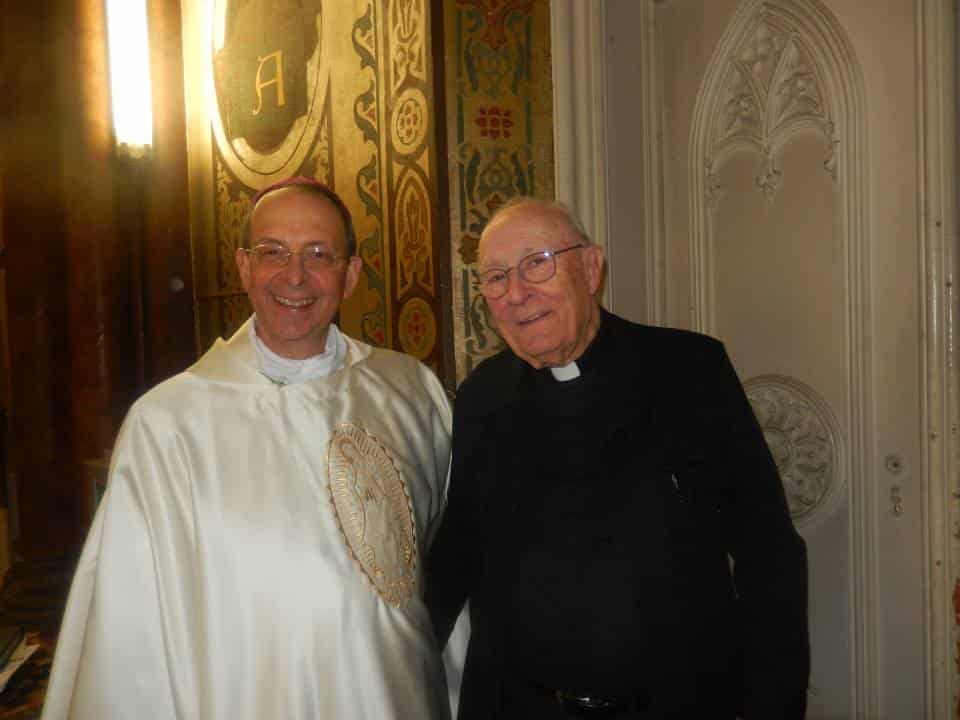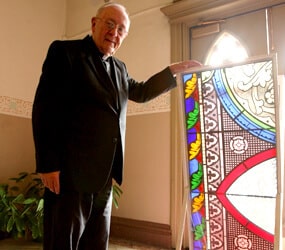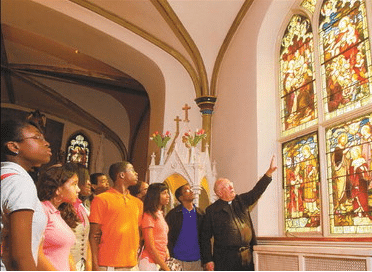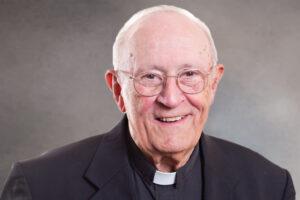
Monsignor Arthur W. Bastress, longtime pastor of the National Shrine of St. Alphonsus Liguori in Baltimore, died July 16. He was 93 and had celebrated 69 years as a priest; he was looking forward to 70.
Baltimore Archbishop William E. Lori called Monsignor Bastress “one of the legendary giants among the priests of Baltimore.”
“His gentle approach, his sharp wit and his priestly heart made him an effective pastor of souls,” the archbishop said in a statement. “He will be deeply missed, but leaves behind an example of what it means to give one’s life over to the Lord and to live it with an eye for the good of others.”
Deacon Justin Gough, who will be ordained to the priesthood for the archdiocese on Aug. 22, remembered Monsignor Bastress as a mentor and friend.
“What he taught me in a special way was to just give every day your all,” said Deacon Gough, whose Lithuanian grandparents had come to know Monsignor Bastress while the priest was serving their ethnic community at the National Shrine of St. Alphonsus Liguori in Baltimore, starting in the late 1990s.
The eldest of five siblings, Monsignor Bastress is survived by his brothers John, Paul and Robert, and his sister, Sister Joan Marie of the Sisters, Servants of the Immaculate Heart of Mary.
The Baltimore family attended Mass at St. Bernardine on Edmondson Avenue; Monsignor Bastress studied at the now-closed parish school and later at what is now Loyola Blakefield in Towson. He trained for the priesthood at St. Charles Minor Seminary, the former St. Mary’s Seminary on Paca Street, and St. Mary’s Seminary in Roland Park.
Ordained in 1951 by Baltimore Archbishop Francis Patrick Keough, Monsignor Bastress served at St. Dominic in Hamilton, St. Patrick in Little Orleans, Holy Trinity in Glen Burnie, St. Andrew by the Bay in Annapolis, and St. Mary in Pylesville during his earlier years as a priest.
His first pastorship was Immaculate Heart of Mary in Baynesville, starting in 1970.
He made a mark as head of the archdiocesan office of the diaconate, a position he held throughout the 1980s.
Starting in 1990, Monsignor Bastress served at various city parishes, including the now-closed St. Jerome, St. Peter the Apostle, and St. Martin, all of which would join to become Transfiguration Catholic Community.
In 1997, he became interim delegate of the Urban Vicariate, after then-Baltimore Auxiliary Bishop John H. Ricard, S.S.J., was sent to lead the Diocese of Pensacola-Tallahassee, Fla.
The following year, Monsignor Bastress was appointed pastor of St. Alphonsus, a role he would continue for the next two decades.
At St. Alphonsus, Monsignor Bastress ministered to the Lithuanian community, general downtown Massgoers and helped establish the parish as a location for the Tridentine rite Mass or the “extraordinary form,” also known as the Traditional Latin Mass. He later helped establish a Tridentine rite Mass at St. Mary in Hagerstown.
“He was just like a dad to me,” said Irene Mann, a former administrative assistant and business manager at St. Alphonsus. “Not only was he very pastoral, but I could go in there and talk to him about anything, and he was very understanding. He was full of wisdom.”

Mann noted that Monsignor Bastress longed to bring St. Alphonsus’ ornate German gothic building back to its former glory, leading a wide range of projects including the restoration of the stained-glass windows, repairs to the steeple, brickwork and more. The priest insisted on never taking a parish loan for the projects, she remembered.
Mann, now a parishioner of St. Rita in Dundalk, worked with the pastor to send out financial appeals several times a year to support the various church improvement and urgent maintenance projects that kept cropping up, some of which were $1 million or more.
“The people always came through,” Mann said, “some of them because of their love of the church, but I surely believe that for 75 percent of them it was for love of Monsignor.”
Thanks to Monsignor Bastress’s work maintaining the church, Mann proudly noted that when an earthquake struck, “we didn’t lose a single brick,” and when a hurricane came through, “not a single shingle came off that church.”
Monsignor Bastress had great devotion to the parish’s namesake and doctor of the church, as well as to St. John Neumann and Blessed Francis X. Seelos. Both were prominent pastors of St. Alphonsus Parish as well as members of the Redemptorists, the religious order founded by the parish’s patron saint.
Father William Spacek, a longtime hospital chaplain who lived with Monsignor Bastress at St. Alphonsus, noted that he would sometimes find the monsignor staring at the door to his office early in the morning.
He would tell Father Spacek about a recurring dream: two priests in distinguished “old-fashioned” clerical garb, walking silently through the St. Alphonsus courtyard.
“Fathers!” Monsignor Bastress would call out. “Who are you?”
The men would turn, stare, and – before they vanished – nod, a silent gesture that Monsignor Bastress would come to take as approval.
With Archbishop Lori’s help, Monsignor Bastress managed to establish St. Alphonsus as a national shrine.

For his efforts, the Redemptorists named him an honorary oblate in 2009.
Monsignor Bastress received various honors throughout his ministry; the title “protonotary apostolic,” granted by the pope, made him the highest-ranking monsignor in the Baltimore Archdiocese at the time of his death.
More often, his peers and superiors honored him with their trust and by making him their go-to whenever some arduous and thankless task required completion.
“Every place I ever went were places nobody else wanted to go,” he told the Catholic Review in 2017, upon his retirement.
Oftentimes, the challenges he accepted were people.
“He believed that everybody was entitled to another chance,” said Father Spacek, adding that the monsignor had helped more than one priest with a drinking problem:
“Many times he would be called up while at Immaculate Heart – ‘We’ve got a priest for you, Art. Can you handle it?’”
The response was always the same: “Sure – send him over.”
The monsignor didn’t work all the time. A self-taught organist, his love for music always surprised those who got to know him.
“He himself played organ for many years at St. Alphonsus,” said Father Marc Lanoue, associate pastor of St. Ignatius Parish in Hickory. “He played and led the choir while Father Casimir Peterson celebrated the Tridentine-rite Mass. When Father Peterson was no longer functioning, Monsignor Bastress had to be celebrant and he very much missed leading the choir.”
Father Lanoue had initially sought out Monsignor Bastress to learn the Tridentine rite. Ordained prior to the Second Vatican Council, the monsignor was one of the archdiocese’s few remaining priests trained in the Latin Mass.

For years, Monsignor Bastress brought his choir from St. Alphonsus to Hickory every Christmas to join the St. Ignatius choir for a concert, Father Lanoue added.
According to Father Spacek, the monsignor kept up his subscription to the Baltimore Symphony Orchestra during his retirement, and the two would often attend concerts after dinner at the Peppermill Restaurant in Lutherville, sometimes accompanied by one or more of Monsignor Bastress’s brothers.
At St. Stephen’s Green, the assisted-living facility that served as his home following his 2017 retirement, Monsignor Bastress led a daily rosary and, during Lent, the Stations of the Cross, according to Father Spacek and Deacon Gough.
He prayed the Liturgy of the Hours every day and continued to offer his counsel to various priests of the archdiocese, who continued to seek it.
Father Spacek told the Review that Monsignor Bastress died in the morning, soon after breakfast. He had been happily anticipating the visit from Deacon Gough, scheduled for later that day. He moved from his breakfast chair to a recliner near the outer door to his room, where he passed.
“I think he was expecting a visit from the Lord,” Father Spacek said.
George Matysek Jr. contributed to this story.
Arrangements
(Note that because of social distancing requirements during the coronavirus pandemic, seating will be limited.)
Visitation:
July 19, 4-8 p.m. at Immaculate Heart of Mary, Baynesville, and July 20, 10-11 a.m. at the Cathedral of Mary Our Queen in Homeland. A vigil service will be offered July 19 at 7 p.m. at Immaculate Heart of Mary.
Funeral Mass:
July 20 at 11 a.m. at the Cathedral of Mary Our Queen. It will be livestreamed at www.cathedralofmary.org/webcast.
Also see:
After nearly 66 years in ministry, Monsignor Bastress retires
Monsignor Bastress awarded Redemptorists’ highest honor
Amen: On a humble man, and famous last words
Tridentine Mass in Hagerstown speaks to ‘majesty of the church’
St. Alphonsus Shrine entrusted to Priestly Fraternity of St. Peter
Copyright © 2020 Catholic Review Media
